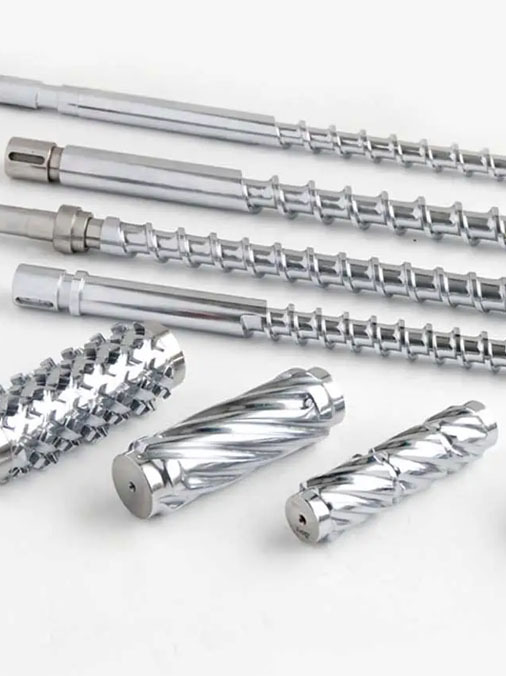
NEWS CENTER
How to judge the output of extruder screw?
The output is a main index to evaluate the performance of extruder screw. However, it is not significant to only emphasize the percentage increase in the output of the improved screw compared with the original screw, because the benchmark for comparison is not clear. From the theory of fluid dynamics, we know that the output will be greatly improved if the worn screw is replaced by the screw with smaller screw clearance. In order to accurately reflect the performance of the screw, the following four aspects can be compared.
The output is a main index to evaluate the performance of extruder screw. However, it is not significant to only emphasize the percentage increase in the output of the improved screw compared with the original screw, because the benchmark for comparison is not clear. From the theory of fluid dynamics, we know that the output will be greatly improved if the worn screw is replaced by the screw with smaller screw clearance. In order to accurately reflect the performance of the screw, the following four aspects can be compared.
1. Specific flow rate (Q/n), that is, under the premise of qualified quality, compare the output under different screw unit speeds. Since the actual output Q (kg, Hr) and rotational speed (rpm) can be measured, the specific flow Q/n is easy to calculate. Its unit is (kg/Hr)/rpm, that is, the hourly output of the screw per revolution
If the Q/n value is too small, other comparisons are meaningless, because it means that the screw design is unreasonable, or the process operating conditions are unreasonable, or the process operating conditions are unreasonable. For example, for ф For an extruder, the Q/n value below 0.24 is probably lower; And to ф For extruders, Q/n value should be better than 2, and Q is the output of polyethylene extruded with die. Of course, these reference figures are only applicable to the current muzzle, which will be broken down.
2. Transmission efficiency η, That is, the ratio of actual output Q to theoretical output Q1.
η= Q/Q1
Actual output can be measured, but there are many calculation methods and formulas for theoretical output Q1. At present, a simplified theoretical formula is generally used:
Q1=FπDpmn=0.06(S-B)H3(D-H3)πpmn (7-2)
The physical meaning of formula (7-2) is that the screw conveys a circular ring of plastic (Figure 7-1) every revolution. The average diameter of the ring is D, and the sectional area F=(S-b) Ha. In the formula, S, b, Ha and D resolution are the screw pitch calculated in cm, the axial distance of the screw ridge, the screw groove depth of the metering section and the screw diameter. n is the rotational speed per minute. The unit of theoretical output is kg/Hr, and P is the density of molten materials. The density of several thermoplastics is shown in Table 7-1
When the screw parameters and density are known, the denominator is constant, so the specific flow Q/n is related to the conveying efficiency η, It is obviously proportional to each other. That is, the higher the specific flow is, the higher the transmission efficiency will inevitably be. Therefore, we can simply compare the conveying efficiency by measuring the specific flow rate.
For screw design, the concept of conveying efficiency is a very important concept, which reflects the comprehensive performance of screw extrusion system. According to the test: under normal conditions, the conveying efficiency of the smooth barrel is 0.30-0.50, which is unlikely to be higher than 0.50, and 0.30 is uneconomical.
It must be pointed out that the specific flow rate and conveying efficiency will be greatly improved when a longitudinal rectangular groove is set on the barrel of the feeding section of the extruder and strong cooling is applied. The working principle of this system (IKV system) is different from that of the smooth barrel system. The latter calculates the theoretical productivity according to the hydrodynamics theory, so it is calculated in the metering section; The productivity of the former is determined by the feeding section.
3. The main goal pursued by the designer of Qmax screw with the highest output is to obtain the highest output as possible on the premise of ensuring the quality. Formula (7-4) can be used to calculate the maximum output of each screw when comparing the maximum output Qmax of two screws.
Qmax=0.85nmax(Q/n) (7-4)
Considering that the normal operating speed of the general extruder is about 85% of the design maximum speed, the coefficient is multiplied by 0.85 in Formula (7-4).
4. "Hardness" of screw characteristics. The so-called "hardness" of screw characteristics refers to the situation that the output decreases when the head pressure increases. It can be seen from Figure 7-2 that the characteristics of screw a are better than that of screw b. That is, when the head pressure increases, the output of screw a decreases less.
Related news
Sharing the Economic Factors of Extruder Screw Design
For any technical problem, it is totally wrong to ignore the economy of design. In some cases, the rationality of screw design must be analyzed more comprehensively, that is, from the perspective of economy.
Functional characteristics of exhaust screw
In the extrusion process, the gas to be discharged from the raw material includes three parts: the air brought in between the raw material particles; Moisture adsorbed on granular materials; Gases or liquids contained in raw materials, such as residual monomers, low molecular volatiles and water, etc.




